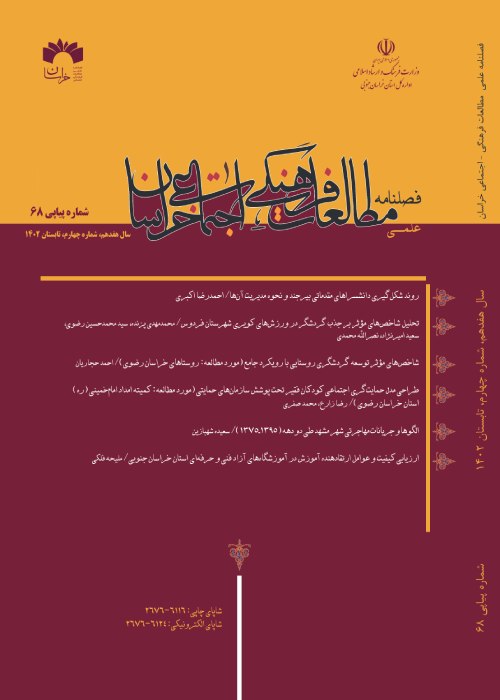Examining the Patterns and Trends of Migration to Mashhad Over the Last Two Decades (1996-2016)
Like many countries worldwide, Iran has experienced significant changes in internal migration patterns. Among the immigration hubs in the country, Khorasan Razavi province has drawn a substantial portion of immigrants from the eastern regions, establishing itself as one of the country’s demographic poles. A significant part of this migration is concentrated in the city of Mashhad. The presence of Imam Reza’s holy shrine has transformed Mashhad into a tourist city that annually welcomes numerous domestic and international tourists. This touristic status, coupled with its advanced levels of social and economic development, has equipped Mashhad with adequate facilities, welfare and educational services, and job opportunities. Consequently, it attracts a large number of people from other regions and even neighboring countries, especially Afghanistan, each year. These factors have led to an increased focus on Mashhad to meet the needs of this population, thereby attracting more immigrants. However, this situation has resulted in a disproportionate distribution of opportunities, facilities, and resources across regions, exacerbating regional development imbalances. Therefore, understanding Mashhad’s migration patterns is crucial for its comprehensive planning and policy-making. Despite the importance of immigration in Mashhad, a review of the research history in the field of immigration reveals that no studies have specifically focused on Mashhad city’s migration. It has only been mentioned in the context of Khorasan-Razavi province in studies such as those by Ziari, Zanjirchi and Sorkh-Kamal (2010), and Zarghani, Hosseini, Ghanbari and Ghiyasi (2016).
In this study, a macro approach and secondary analysis of migration data spanning 20 years have been employed. The required data includes immigration statistics for the city of Mashhad, which are based on the number of immigrants, the influx and outflux of immigrants, the origin of immigration determined by previous residence, and whether the previous residence was urban or rural. The data, which cover the periods of 1996-2006, 2006-2011, and 2011-2016, were obtained from national censuses. The patterns and trends of migration were examined using the following indicators:
In-migration and out-migration rates: These two rates provide information about the rate of immigrants entering and leaving the region. They also form the basis for more advanced and powerful indicators.
The net migration Rate: it indicates the net migration of a region in a certain period of time. The net migration rate determines the residential pattern of the country at a certain time and is of considerable importance. The net migration rate is obtained from the following:Migration effectiveness ratio: This index shows the impact of immigration on population redistribution. The Migration Effectiveness Ratio is obtained from the following:
(Bell et al., 2002, pp. 23-25)
The numerical value derived from this index illustrates the impact of immigration on population redistribution at the regional level. A negative value signifies a population decrease in the region due to migration. Conversely, a positive value indicates that internal migration has contributed to an increase in the region’s population.
The findings reveal that Mashhad has consistently attracted a large number of immigrants. On average, during each census period, more than one hundred thousand immigrants enter the city of Mashhad, with fewer individuals leaving. Consequently, in addition to the population increase due to natural growth, Mashhad also experiences a population increase due to migration. However, based on the emigration and immigration rates in Mashhad, it can be inferred that the city's net immigration has decreased during the study period. Despite this decrease, this metropolis remains one of the country’s primary immigrant destinations due to its net positive migration rate. During each period, approximately 40% of all immigrants entering the province of Khorasan Razavi migrate to the city of Mashhad. The migrations to Mashhad primarily originate from nearby provinces, driven by cultural and geographical affinities. More than 70% of the city’s immigrants come from the provinces of Tehran, North and South Khorasan, and Sistan and Baluchestan. Additionally, in each period, about 4% of the immigrants in Mashhad are foreign immigrants, predominantly from Afghanistan. Following inter-provincial migrations, intra-provincial migration occurs, with the data indicating that the main form of this migration has been intra-county migration. In studying urban and rural migration, the migration pattern of Mashhad aligns with the national model, i.e., the highest migration ratios have consistently been related to urban-to-urban migration.
Given that immigrants entering the city of Mashhad come from diverse age and gender groups and possess varying characteristics, planning for the population increase resulting from migration presents a challenge. The substantial volume of migration to Mashhad has positioned the city as a primary hub within the county and even the province. This phenomenon has emerged following the region’s unbalanced and unequal development. As a result, a large population from other regions with lower levels of development migrates to this metropolis to access its superior economic and educational facilities and services. Provinces such as Sistan-Baluchestan, North Khorasan, and South Khorasan, which are less developed compared to Mashhad, have seen their residents migrate to Mashhad to avail the facilities offered by the city. Therefore, a key factor in reducing these migrations is to establish a balance between the capabilities and economic potentials of different regions. Based on the findings of this study and similar research, one of the most effective solutions is to implement policies of sustainable economic enterprises that align with the potential and capabilities of regions, particularly in smaller cities and regions. Considering the significance of employment in migration, increasing investment and creating employment opportunities in smaller cities can not only prevent residents from migrating but also encourage the return of migrants.
- حق عضویت دریافتی صرف حمایت از نشریات عضو و نگهداری، تکمیل و توسعه مگیران میشود.
- پرداخت حق اشتراک و دانلود مقالات اجازه بازنشر آن در سایر رسانههای چاپی و دیجیتال را به کاربر نمیدهد.



